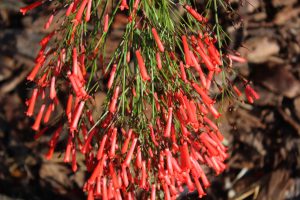
The firecracker plant is a weeping shrub with a very unique look. The lanky, multi-stemmed, three- to four-foot-long branches are often covered in bright red tubular flowers from spring through early winter. Maybe you have a firecracker plant already, or maybe this article will inspire you to get one. While several plants have the common name “firecracker plant”, the firecracker plant aka Russelia equisetiformis is an appropriate name for this dynamite shrub!
We can check off many of the “good” boxes for the firecracker plant right from the get-go. This plant is hardy in our zone, it is drought-tolerant once established and is considered a Florida-Friendly Landscaping™ plant with medium salt tolerance. Make sure the planting site has room to accommodate the five-foot spread and three-foot-tall arching canes. While this shrub can be a bit of an aggressive grower, it is not considered invasive. In fact, the firecracker plant is “not a problem species” according to the UF/IFAS Assessment of Non-Native Plants in Florida’s Natural Areas. This flowering shrub is also very attractive to pollinators and hummingbirds commonly drawn to the irresistible tubular blossoms. Originally from Mexico, this rush-like shrub has a very unusual appearance with leafless stems adorned with bracts instead leaves. While often just used as a specimen plant, the firecracker can be situated for a mass planting or used as a border to higher plants. If planted in mass, set plants at least thirty-six inches apart as each individual plant will soon fill in the spaces. Russelia equisetiformis may be at its best when installed so that it cascades down a wall taking advantage of those wispy branches. It has also been used in large hanging baskets to take advantage of the arching nature of its flexible stems. Situate your firecracker plants in full sun for best flowering results.
While you may normally only see red firecracker plants in local garden centers, on occasion you will also find a yellow cultivar known as ‘Aureus’. This pale-yellow cultivar is an interesting change of color with the same plant characteristics. One additional cultivar has salmon-orange-colored flowers – a nice complement to the other color choices.
If the firecracker plant is new to you, why not add one to your landscape! If you have a red one already, try a yellow or salmon color variety to jazz up your landscape! In any case, for more information on all types of colorful flowering shrubs suitable for our area, you can also call the Master Gardener Volunteer Helpdesk on Mondays, Wednesdays, and Fridays from 1 to 4 pm at 764-4340 for gardening help and insight into their role as an Extension volunteer. Ralph E. Mitchell is the Director/Horticulture Agent for the UF/IFAS Extension Charlotte County. He can be reached at 941-764-4344 or ralph.mitchell@charlottecountyfl.gov.
Resources:
UF/IFAS Gardening Solutions (2021) Firecracker Plant. The University of Florida Extension Service, IFAS.
The Florida-Friendly Landscaping™ Guide to Plant Selection & Landscape Design, 1st ed. (2010). The University of Florida Extension Service, IFAS.
The UF/IFAS Assessment of Non-native Plants in Florida’s Natural Areas. (2022) The University of Florida Extension Service, IFAS.
Landre, C. (2022) Firecracker Plant – Russelia equisetiformis. South-Florida-Plant-Guide.com.
 1
1
